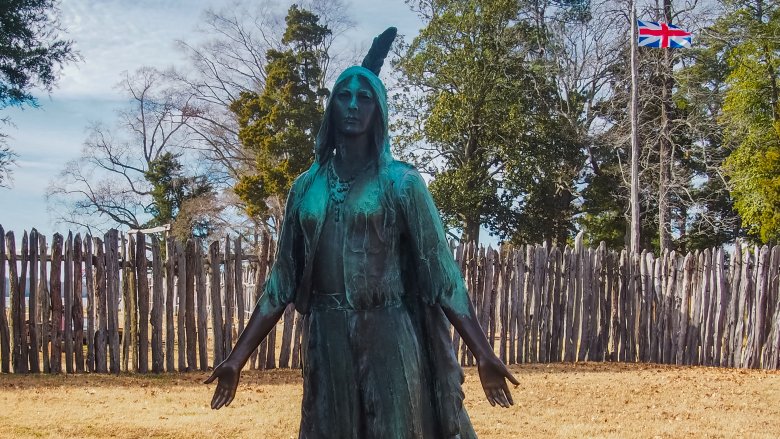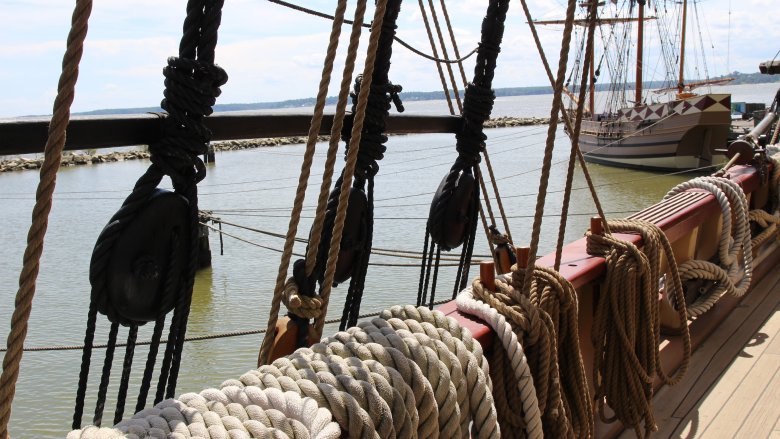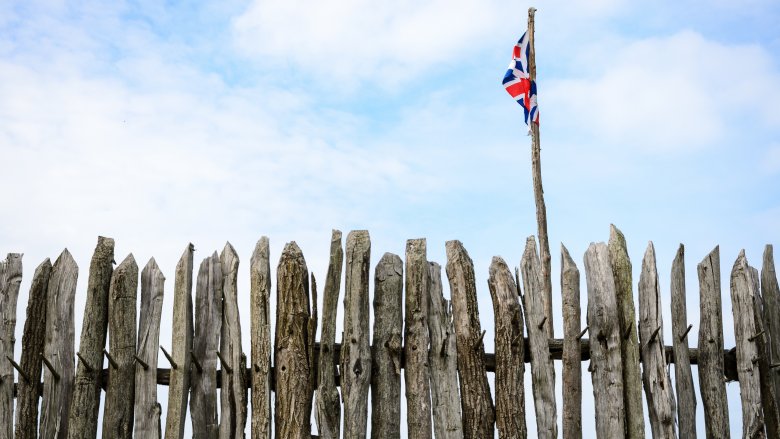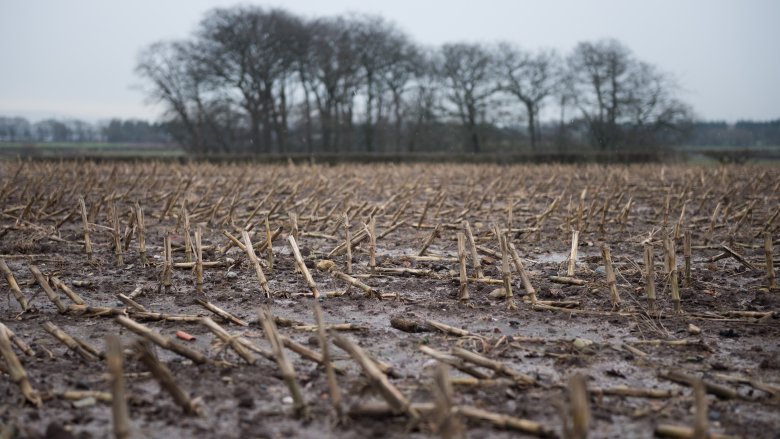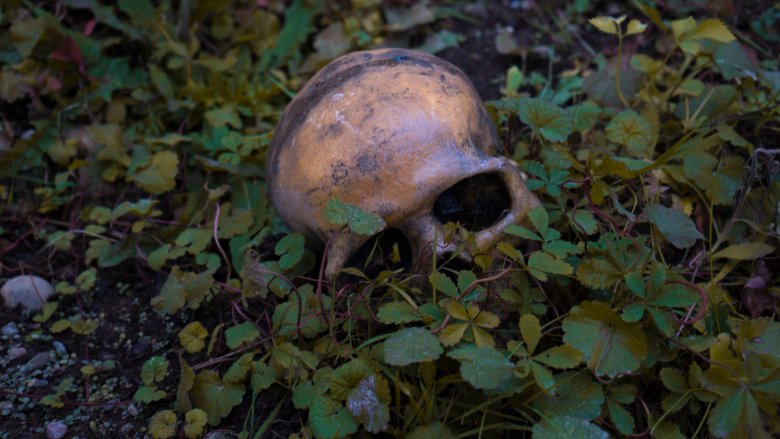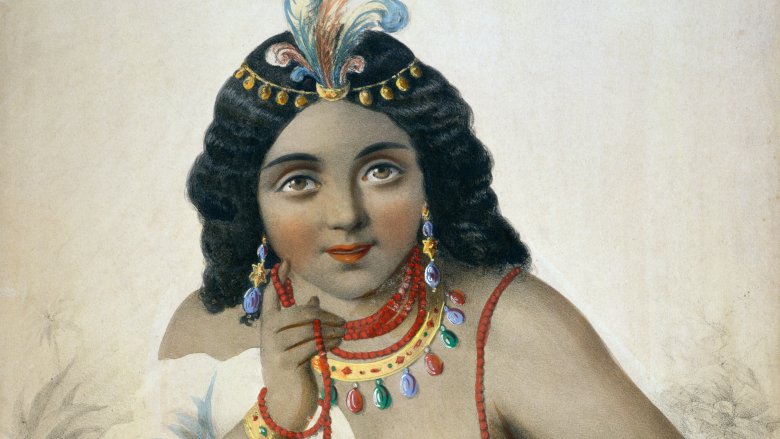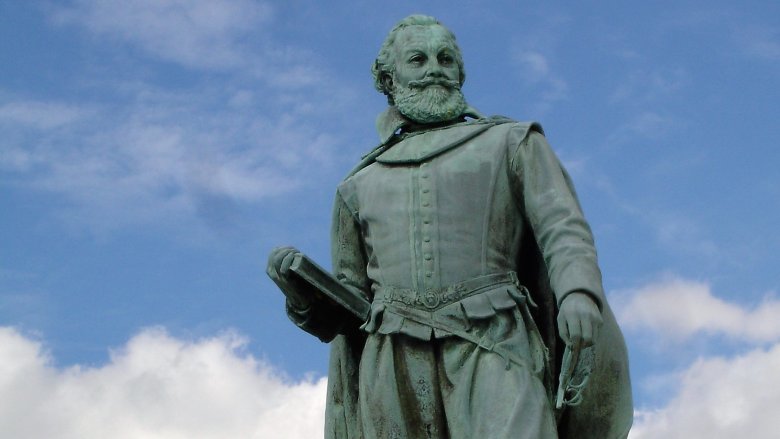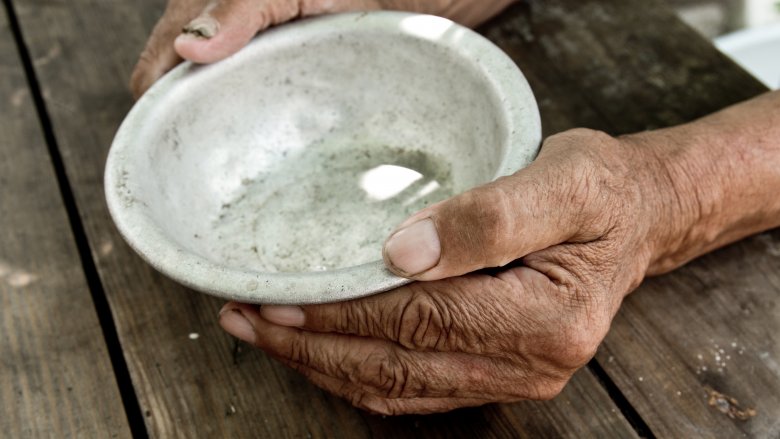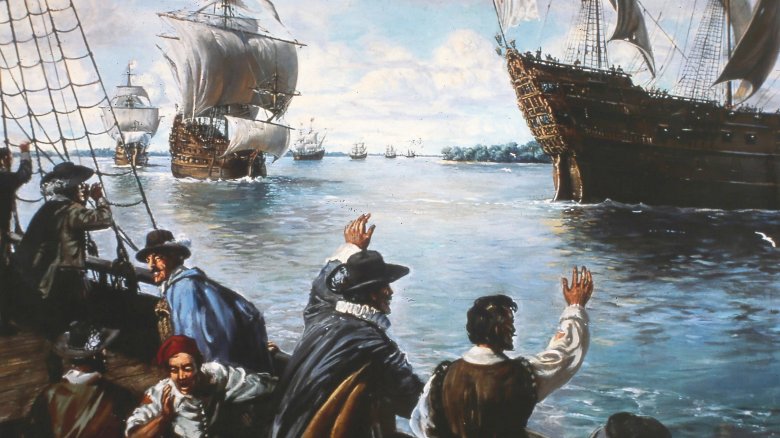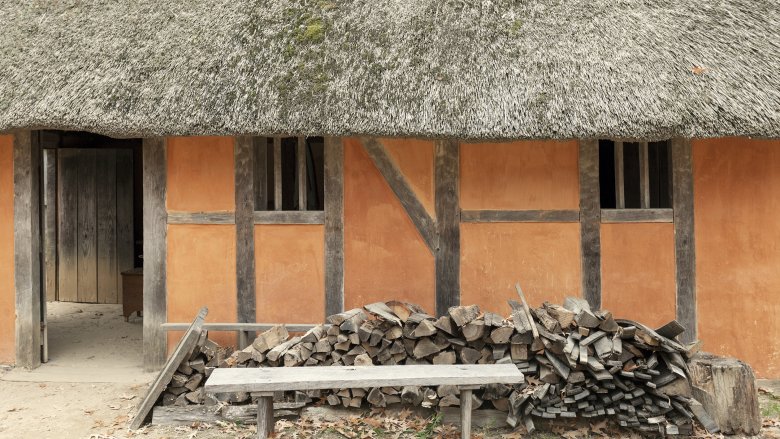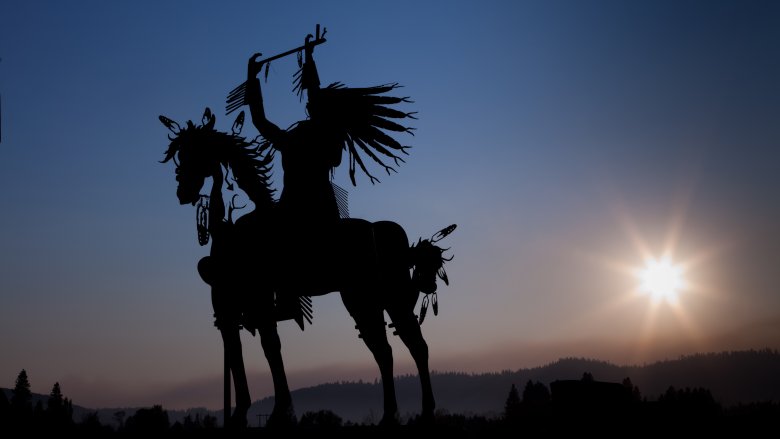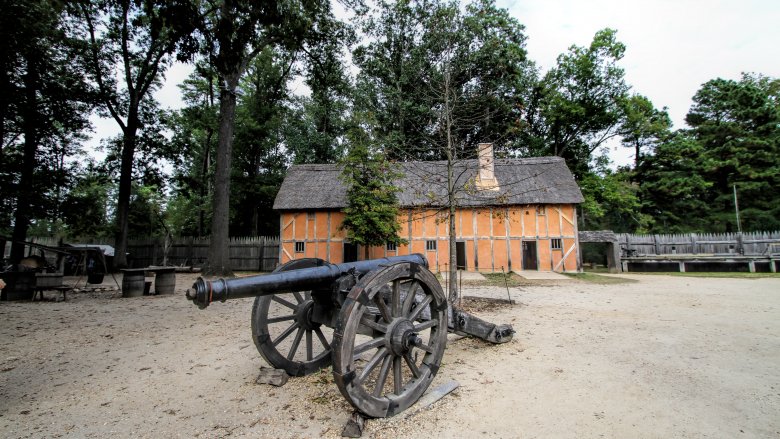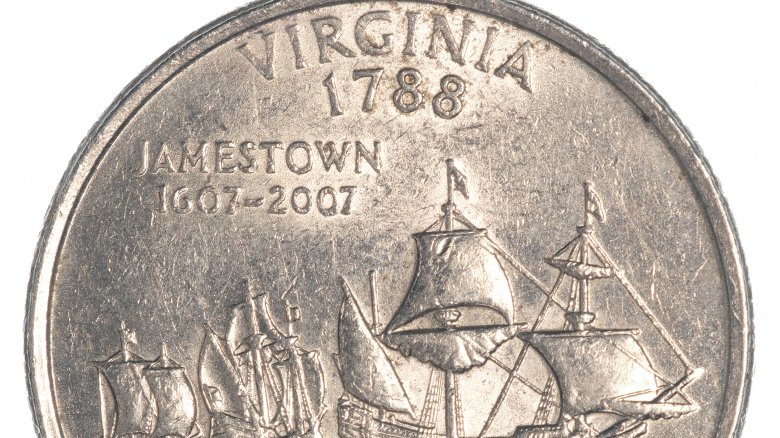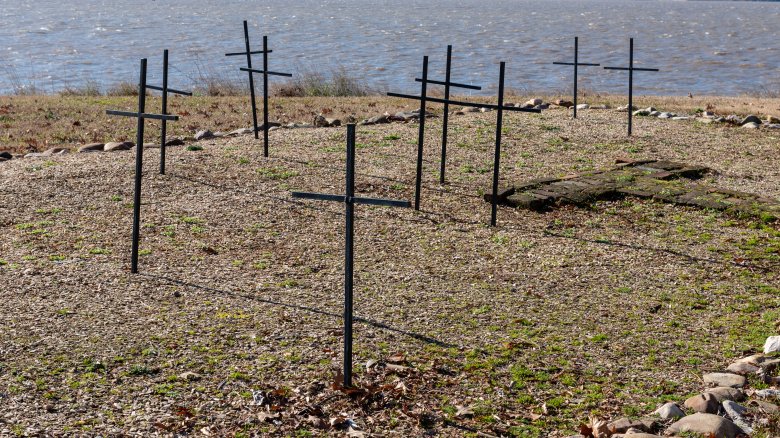The Tragic True Story Of The Jamestown Settlement
When it comes to the "discovery" of America, the storybook narrative you learned in elementary school is way off the mark. It's hard to dispute the arrogance — and hostility — of European powers laying claim to land that had been occupied by indigenous cultures for centuries, and real-life colonization definitely wasn't a fanciful tale of Pilgrims, Thanksgiving dinner tables, and handshake agreements: It was a brutal, bloody time where people like Christopher Columbus committed monstrously genocidal actions, wars broke out every decade, and disease was widespread. Ugly stuff.
Over a century after Columbus, though, and years before the Pilgrims sailed to Massachusetts in search of religious freedom, the story of the USA truly began with a rough little colony named Jamestown, Virginia, which would go down in history as the first successful English settlement of the New World. If you think camping in the woods is rugged, well ... Jamestown's first settlers had to contend with harsh weather, fatal sickness, and starvation so bad that they (literally) started cannibalizing each other's dead bodies. Clearly, the true story of Jamestown wasn't anything like Disney's Pocahontas.
A long, long time ago...
Jamestown's founding in 1607 predated the arrival of the Pilgrims by 13 years, according to Christian Science Monitor. When the first 100 Englishmen to form Jamestown docked their anchors in Virginian shores, though, they weren't seeking out any noble goals, philosophical freedom, or high aspirations: nah, all they wanted was money. What makes Jamestown's story so interesting, from a historical perspective, is that it's like the dark, depressing prequel to the blockbuster movie that would eventually become the United States. All the key themes are introduced, the problems get started, and then nothing is resolved for hundreds of years.
While the founders of Jamestown hoped for silver and gold, what they found instead was desperate hardship. Certain good things came from their struggles, of course, such as the founding of the first European representative governing body in the Western Hemisphere — arguably paving the way for the USA's democratic future — but on the other hand, the bad parts of Jamestown's legacy are awfully bad. For one, it was in Virginia where settlers first initiated centuries of atrocities upon the land's indigenous people. By 1619, History says, enslaved Africans were sold on Virginian shores, the first time in the continent's history. While these people were technically classified as "indentured servants," Jamestown marked the beginning of American slavery, a horrific institution that would forever mar the history books.
Before there were Americans, they were all Virginians
Jamestown was always in Virginia, but Virginia meant something different than it does today. Back in the 1600s, as far as England was concerned, the name Virginia referred to any North American land that the Spanish or the French hadn't gotten to first, according to State Symbols USA. This name was chosen in honor of Queen Elizabeth I, who was often referred to as "the Virgin Queen" due to the fact that she never married. Not too likely that she was actually a virgin, but the name stuck. Over a century later, in 1788, the area surrounding the old Jamestown colony was officially ratified as Virginia, the 10th state of the United States of America. From there, you know the drill.
As for the name Jamestown? While it's fun to imagine that the settlers might've had some deadly racing competition to determine whose name got first place, the National Park Service says that it was just named after King James of England.
They were totally unprepared
Imagine applying for what looks like a great job with a big paycheck, then finding out that the pay sucks and even the most routine assignments will break your back. That's basically what happened to the profit-driven colonizers of Jamestown, and as soon as they hopped off the boat in Virginia, nothing went smoothly.
Those first group of settlers to build up Jamestown in 1607, according to History, were male skilled workers: blacksmiths, carpenters, masons, the basic stuff. The local Powhatan tribe was wary of the newcomers, so the Jamestown settlers wanted to get swiftly established, and they put up walls and roofs in only a few weeks. Tensions with the Powhatan only got worse from there, but the settlers soon encountered even harder problems they hadn't anticipated: harsh winters, famine, starvation, and widespread disease. By the end of Jamestown's first year, only 38 of the original 100 men were still alive.
Cannibalism
If there's one part of Jamestown's story that most resembles a horror movie, it's definitely those early winters. The cold temperatures were hard enough, according to National Geographic, but the real crisis was a swiftly diminishing food supply. As the settlers got hungrier, they also got more desperate, eventually resorting to dining on rats, mice, cats, horses, and dogs. When that wasn't enough, they ate leather boots. Even at this point, the famine still hadn't ended, and more people kept starving, getting sick, and dying. Finally, the starvation reached such a point that the colonists started eating each other. Some people reportedly dug corpses out of graves. One particularly gruesome account describes a man cutting up his own pregnant wife, salting the pieces, and eating them. Until fairly recently, these horrific stories were unproven hearsay, but in 2013, archaeologists finally uncovered the physical evidence of a girl who'd been butchered.
Everything you think you know about Pocahontas is wrong
In recent years, Pocahontas has been used as an ethnic slur against Native Americans. Before that, it was the title of a 1995 Disney film (loosely) inspired by Jamestown history. Pocahontas wasn't the real name of the girl who inspired the legend — her actual name was Amonute and/or Matoaka, but "Pocahontas" was a childhood nickname. As for the fanciful narrative of Pocahontas being a Native American woman who falls in love with an Englishman named John Smith, his culture, and Christianity ... well, it's inaccurate at best and wildly offensive at worst. For one, Amonute was only an 11-year-old girl when she met Smith, according to the Smithsonian. She and Smith did teach their languages to each other, but their alleged epic romance is generally believed to be a rather creepy fabrication by Smith. As History points out, the settler she later married was actually John Rolfe, and even that might've just been a political move. Even the story of her risking her life to save Smith is highly debated, as it might've been a tribal welcoming ritual which Smith either grossly misunderstood or outright lied about.
The biggest problem with the whitewashed Pocahontas mythology, though, is it paints her as seemingly worshiping European culture at the expense of her own, when reality was far more complex. The real Amonute was a leader, a translator, and an ambassador for peace who desperately tried to help her people resist the overwhelming European imperialism.
John Smith was a total jerk, by the way
Forget everything you know about Captain John Smith, too, because the source that made him look like such a dashing hero was Smith himself. As an old 1958 American Heritage article points out, Smith was a braggart who lied his way into the history books, claiming he saved Jamestown from starvation by cutting a deal with the Powhatan people. In reality? Smith was such an unpopular guy that Jamestown sentenced him to hang, according to Live Science, and he only survived because the sudden arrival of 100 new settlers from England was so distracting that everyone forgot to murder him.
Somehow, Mr. Unpopular became president of Jamestown, a position which released his inner tyrant in all kinds of awful ways: When famine came and the Powhatan people didn't have extra food to spare for the colonists, Smith burned down Powhatan villages, abused and slaughtered their people, and forced them into slavery. Not a nice guy. Eventually, Smith was severely burned in a gunpowder explosion and hopped on the next boat back to England. Needless to say, nobody missed him. According to one fellow Jamestown resident, Smith was "an Ambityous unworthy and vayneglorious fellowe," which, in 1600s English, is a pretty serious middle finger.
It gets even uglier
Those Jamestown colonists went through a lot of rough periods, but probably the worst of them all was the so-called "Starving Time," which might sound like the title of a grim Black Mirror episode, but was actually the winter of 1609-1610, according to Historic Jamestowne. When John Smith hightailed it back to England, he left George Percy in command, and Percy was stuck between a rock and a hard place: Food supplies were at an all-time low, and Smith's violent policies had so angered the local tribes that they attacked any colonists who stepped outside Jamestown's walls. As a result, everyone bundled up for the winter, locked themselves inside, ate whatever scraps (or animals, or leather, or dead people) they could find, and got really, really sick. Diseases such as typhoid and dysentery became prevalent. By that spring, two out of every three Jamestown colonists had died.
After going through this nightmare, everyone wanted out. In June, the colonists planned to follow Smith's example and sail back to England, leaving their Jamestown disaster behind, but the mother country didn't approve. The fleeing colonists were blocked from escaping by the ship of new governor Lord De la Warr, and they had to return.
Tobacco saves everybody, for once
If anyone deserves credit for rescuing Jamestown from oblivion, it's not John Smith, but rather, John Rolfe. In 1610, History says Rolfe docked at the beleaguered shores of Jamestown, as part of a new 150-person crew. Just as important as the new blood, though, were the contents in Rolfe's pocket: tobacco seeds. Once these seeds were planted, they sprouted like crazy, the money came pouring in, and tobacco became Jamestown's first profitable export. According to Ancestry, the sudden growth of Virginian tobacco was a cash cow that revitalized the colony's economy, and tobacco continued to be Virginia's top export from the 17th century until nearly the 21st century.
As for Rolfe? He married Amonute, aka Pocahontas, though at this point she was calling herself Lady Rebecca, probably in an effort to create peace between her tribe and the settlers. She and Rolfe had a son, Thomas, and journeyed to England. That didn't go so well. Just seven months later, she fell sick and died.
American democracy begins
If Jamestown sounds like a "worst hits" album where everything that would go wrong in the future America was foreshadowed like crazy, well, it kind of was. On the other hand, though, one glowingly positive aspect of the future United States got its start in Jamestown, too, and that was American democracy, according to Historic Jamestowne.
In 1619, the colony's General Assembly met for the first time, marking the first occasion wherein a democratically elected representative governing body met in the Americas. Twenty-two burgesses (representatives) were voted on by the residents of the colony, thus allowing some of the population to participate in their own government for the first time. The General Assembly would grow over time, eventually spawning the Virginia House of Burgesses. Decades later, in 1758, a lad named George Washington would win a seat in this House, thus paving the way for his political future.
The Powhatan fight back
Starting American democracy is swell and all, but Jamestown didn't encounter smooth sailing from there, mostly because the colonists continued being bigoted, moralizing jerks to the local indigenous tribes. By this point, as Virtual Jamestown explains, the colonists were attempting to integrate the Powhatan people into European culture, with "integration" actually meaning that they wanted the natives to abandon their customs, destroy their culture, and become nice little subservient Christian converts. Needless to say, the indigenous population wasn't happy about this, nor about the fact that they had to face constant insults, prejudice, mockery, and diseases (like smallpox) from the settlers. According to Encyclopedia.com, the powder keg finally blew when English colonists murdered a beloved Powhatan shaman and warrior named Nemattanew.
Finally, the Powhatan community rebelled. Their violent attack tore through the colony's livestock, farms, and plantations, and in the process, they killed at least 347 settlers — at this point, nearly a quarter of Virginia's English population — thereby leading the English colonists right into another devastating winter without proper food or supplies.
War, war, more war
While the Powhatans did manage to punch the Virginia colony right in the gut, the overall repercussions of their attack weren't good for the native population. A new war had been ignited, followed by yet another war, all of which eventually decimated the local indigenous community.
According to Live Science, new settlers from England soon replaced the dead ones, and this aggressive "massacre" gave the colonists the justification they'd long wanted to engage in full-on warfare with the tribe. Things got nasty, to say the least. At one point, the English went so far as to invite all the nearby indigenous leaders to engage in peace talks, where they were served poisoned wine and shot at. For about 10 years, according to Encyclopedia Virginia, the English settlers systematically devastated the native people's food supply, with one particularly huge battle leading to the destruction of enough food to feed 4,000 people for a year. When the conflict finally lightened up in 1632 thanks to an agreement between both sides, the English were the victors since they'd managed to spread deeper into more territory, while Powhatan power had fragmented under the hardships of the war.
Despite the odds, Jamestown somehow was a success
Yes, those early years at Jamestown were definitely a tale of woe, misery, and bloodshed. However, it is worth nothing that despite all of the cannibalism, wars, and diseases, the Jamestown colony ended up being — for better or worse — a success.
Keep in mind, Jamestown wasn't the first time Europe tried to colonize the New World. As the Constitution Center points out, the Spanish, French, and even the English had made a variety of disastrous prior efforts, which had crashed and burned as they encountered the same issues. What makes Jamestown unique on a historic level, according to Live Science, is that it was the first permanent English settlement that actually lasted. After some seriously shaky beginnings, Jamestown grew into a thriving port town, and even served as the capital of the Virginia colony for almost a century. That reign ended when its major state house burned down in 1698, and a year later, Williamsburg took over as the capitol.
Jamestown today
If you had a time machine and could visit any of the wondrous places and time periods in world history, there are probably a million things you'd rather do before spending a month starving to death in 1600s Jamestown. However, the remains of the original colony are still around today, and while you definitely can't rent a 400-year-old apartment in "downtown" Jamestown, you can spend a few hours exploring what is now preserved as Historic Jamestowne.
Much of what is known about the Virginia colony today is thanks to the Jamestown Rediscovery Project, launched in 1994 by Dr. William Kelso, which has successfully uncovered mountains of history, dug up new insights, and helped paint a clearer picture of what the settlers really went through. Today's visitors can explore the old James Fort, watch live excavations, and tour the Archaearium, a museum housing over 2 million artifacts discovered since the project began.
The old Jamestown settlement might not be a "town" anymore, but its strange and tortured legacy will certainly live on.
